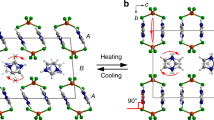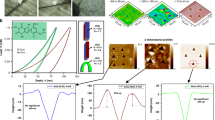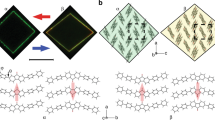Abstract
The counterintuitive phenomenon of negative linear compressibility (NLC) is a highly desirable but rare property exploitable in the development of artificial muscles1, actuators2 and next-generation pressure sensors3. In all cases, material performance is directly related to the magnitude of intrinsic NLC response. Here we show the molecular framework material zinc(II) dicyanoaurate(I), Zn[Au(CN)2]2, exhibits the most extreme and persistent NLC behaviour yet reported: under increasing hydrostatic pressure its crystal structure expands in one direction at a rate that is an order of magnitude greater than both the typical contraction observed for common engineering materials4 and also the anomalous expansion in established NLC candidates3. This extreme behaviour arises from the honeycomb-like structure of Zn[Au(CN)2]2 coupling volume reduction to uniaxial expansion5, and helical Au…Au ‘aurophilic’ interactions6 accommodating abnormally large linear strains by functioning as supramolecular springs.
This is a preview of subscription content, access via your institution
Access options




Similar content being viewed by others
References
Aliev, A. E. et al. Giant-stroke, superelastic carbon nanotube aerogel muscles. Science 323, 1575–1578 (2009).
Spinks, G. M. et al. Pneumatic carbon nanotube actuators. Adv. Mater. 14, 1728–1731 (2002).
Baughman, R., Stafstrom, S., Cui, C. & Dantas, S. Materials with negative compressibilities in one or more dimensions. Science 279, 1522–1524 (1998).
Newnham, R. E. Properties of Materials (Oxford Univ. Press, 2005).
Grima, J., Attard, D., Caruana-Gauci, R. & Gatt, R. Negative linear compressibility of hexagonal honeycombs and related systems. Scr. Mater. 65, 565–568 (2011).
Schmidbauer, H. The aurophilicity phenomenon: A decade of experimental findings, theoretical concepts and emerging applications. Gold Bull. 33, 3–10 (2000).
Zhang, H. L. et al. Static equation of state of bcc iron. Phys. Rev. B 82, 132409 (2010).
McCann, D. R., Cartz, L., Schmunk, R. E. & Harker, Y. D. Compressibility of hexagonal selenium by X-ray and neutron diffraction. J. Appl. Phys. 43, 1432–1436 (1972).
Lakes, R. S. Foam structures with a negative Poisson’s ratio. Science 235, 1038–1040 (1987).
Evans, K. E., Nkansah, M. A., Hutchinson, I. J. & Rogers, S. C. Molecular network design. Nature 353, 124 (1991).
Greaves, G. N., Greer, A. L., Lakes, R. S. & Rouxel, T. Poisson’s ratio and modern materials. Nature Mater. 10, 823–837 (2011).
O’Reilly, J. C., Ritter, D. A. & Carrier, D. R. Hydrostatic locomotion in a limbless tetrapod. Nature 386, 269–272 (1997).
Fortes, A. D., Suard, E. & Knight, K. S. Negative linear compressibility and massive anisotropic thermal expansion in methanol monohydrate. Science 331, 742–746 (2011).
Li, W. et al. Negative linear compressibility of a metal-organic framework. J. Am. Chem. Soc. 134, 11940–11943 (2012).
Ogborn, J. M., Collings, I. E., Moggach, S. A., Thompson, A. L. & Goodwin, A. L. Supramolecular mechanics in a metal-organic framework. Chem. Sci. 3, 3011–3017 (2012).
Shepherd, H. J. et al. Antagonism between extreme negative linear compression and spin crossover in [Fe(dpp)2(NCS)2]·py. Angew. Chem. Int. Ed. 51, 3910–3914 (2012).
Cairns, A. B., Thompson, A. L., Tucker, M. G., Haines, J. & Goodwin, A. L. Rational design of materials with extreme negative compressibility: Selective soft-mode frustration in KMn[Ag(CN)2]3 . J. Am. Chem. Soc. 134, 4454–4456 (2012).
Lakes, R. & Wojciechowski, K. W. Negative compressibility, negative Poisson’s ratio, and stability. Phys. Status Solidi B 245, 545–551 (2008).
Gatt, R. & Grima, J. N. Negative compressibility. Phys. Status Solidi Rapid Res. Lett. 2, 236–238 (2008).
Nicolaou, Z. G. & Motter, A. E. Mechanical metamaterials with negative compressibility transitions. Nature Mater. 11, 608–613 (2012).
Sears, D. R. & Klug, H. P. Density and expansivity of solid xenon. J. Chem. Phys. 37, 3002–3006 (1962).
Hoskins, B. F., Robson, R. & Scarlett, N. V. Y. Six interpenetrating quartz-like nets in the structure of ZnAu2(CN)4 . Angew. Chem. Int. Ed. 34, 1203–1204 (1995).
Katz, M. J., Ramnial, T., Yu, H-Z. & Leznoff, D. B. Polymorphism of Zn[Au(CN)2]2 and Its luminescent sensory response to NH3 vapor. J. Am. Chem. Soc. 130, 10662–10673 (2008).
Goodwin, A. L., Kennedy, B. J. & Kepert, C. J. Thermal expansion matching via framework flexibility in zinc dicyanometallates. J. Am. Chem. Soc. 131, 6334–6335 (2009).
O’Grady, E. & Kaltsoyannis, N. Does metallophilicity increase or decrease down group 11? Computational investigations of [Cl–M–PH3]2 (M = Cu, Ag, Au, [111]). Phys. Chem. Chem. Phys. 6, 680–687 (2004).
Cliffe, M. J. & Goodwin, A. L. PASCal: A principal-axis strain calculator for thermal expansion and compressibility determination. J. Appl. Crystallogr. 45, 1321–1329 (2012).
Chapman, K. W. & Chupas, P. J. Pressure enhancement of negative thermal expansion behavior and induced framework softening in zinc cyanide. J. Am. Chem. Soc. 129, 10090–10091 (2007).
Korčok, J. L., Katz, M. J. & Leznoff, D. B. Impact of metallophilicity on colossal positive and negative thermal expansion in a series of isostructural dicyanometallate coordination polymers. J. Am. Chem. Soc. 131, 4866–4871 (2009).
Goodwin, A. L., Keen, D. A. & Tucker, M. G. Large negative linear compressibility of Ag3[Co(CN)6]. Proc. Natl Acad. Sci. USA 105, 18708–18713 (2008).
Kier, W. M. & Smith, K. K. Tongues, tentacles and trunks: The biomechanics of movement in muscular-hydrostats. Zool. J. Linn. Soc. 83, 307–324 (1985).
Sun, J. et al. QMOF-1 and QMOF-2: Three-dimensional metal–organic open frameworks with a quartzlike topology. Angew. Chem. Int. Ed. 41, 4471–4473 (2002).
Klotz, S., Chervin, J-C., Munsch, P. & Marchand, G. L. Hydrostatic limits of 11 pressure transmitting media. J. Phys. D 42, 075413 (2009).
Acknowledgements
A.B.C. and A.L.G. acknowledge financial support from the EPSRC (EP/G004528/2) and the ERC (Grant Ref: 279705), and are grateful to R. I. Cooper and P. J. Saines (Oxford) for assistance. J.H. thanks H. Shepherd, G. Molnar (LCC, Toulouse), D. Maurin (L2C), D. Bourgogne (ICGM), S. Klotz (IMPMC, Paris), K. Murato (Osaka) and D. Granier (ICGM) for technical assistance, and the ANR for financial support (Contract ANR-09-BLAN-0018-01).
Author information
Authors and Affiliations
Contributions
A.B.C., J.H. and A.L.G. conceived the study; A.B.C. made the sample; A.B.C., J.C., C.L., J.R., A.v.d.L., A.L.T, V.D., J.H. and A.L.G. performed the experiments; A.B.C., L.P., J.H. and A.L.G. analysed and interpreted the data; A.B.C. and A.L.G. wrote the paper.
Corresponding author
Ethics declarations
Competing interests
The authors declare no competing financial interests.
Supplementary information
Supplementary Information
Supplementary Information (PDF 1477 kb)
Rights and permissions
About this article
Cite this article
Cairns, A., Catafesta, J., Levelut, C. et al. Giant negative linear compressibility in zinc dicyanoaurate. Nature Mater 12, 212–216 (2013). https://doi.org/10.1038/nmat3551
Received:
Accepted:
Published:
Issue Date:
DOI: https://doi.org/10.1038/nmat3551
This article is cited by
-
Giant uniaxial negative thermal expansion in FeZr2 alloy over a wide temperature range
Nature Communications (2023)
-
Negative area compressibility in silver oxalate
Journal of Materials Science (2021)
-
Crystal Structure, Infrared Spectrum and Elastic Anomalies in Tuperssuatsiaite
Scientific Reports (2020)
-
Anomalous mechanical materials squeezing three-dimensional volume compressibility into one dimension
Nature Communications (2020)
-
Impact resistance of composite magnetic metamaterials
Scientific Reports (2019)



